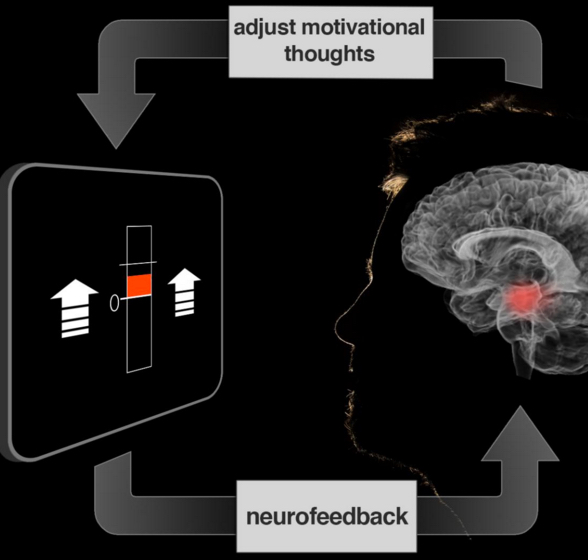A neurofeedback technique for self-motivation
March 15, 2016

This illustration shows an experiment in which subjects received real-time feedback during an MRI scan that showed activity in a reward center of their brain. Without feedback, they were unable to reliably increase activity in the Ventral Tegmental Area (VTA, in red), but the fluctuating thermometer helped them learn and adopt effective strategies by thinking about motivating themselves. Their self-generated boosts in VTA activation then worked even after the thermometer display was removed. (credit: Jeff MacInnes, Duke University)
Duke University scientists have developed a “neurofeedback” technique to improve self motivation by manipulating specific neural circuits using thoughts and imagery. (Neurofeedback is a specialized form of biofeedback that can help generate strategies to overcome anxiety and stress or to cope with other medical conditions.)
“These methods show a direct route for manipulating brain networks centrally involved in healthy brain function and daily behavior,” said the study’s senior investigator R. Alison Adcock, an assistant professor of psychiatry and behavioral sciences and associate director of the Center for Cognitive Neuroscience in the Duke University Institute for Brain Sciences.
Triggering pleasurable brain sensations
The study used functional magnetic resonance imaging (fMRI), which measures changes in blood oxygen levels, allowing more precisely localized measurements of brain activity than with EEG. Specifically, the study focused on the ventral tegmental area (VTA), a small area deep within the brain that is a major source of dopamine, a neurochemical well known for its role in motivation, experiencing rewards, learning, and memory.
The VTA area is also implicated in the drug and natural reward circuitry of the brain. It is important in cognition, motivation, orgasm, and intense emotions relating to love.
According to Adcock’s previous research, when people are given incentives to remember specific images, an increase in VTA activation before the image appears predicts whether the participants are going to successfully remember the image.
In the new study, described in the March 16 issue of the journal Neuron, the team first encouraged participants in the scanner to generate feelings of motivation — using their own personal strategies — during 20-second intervals. They weren’t able to raise their VTA activity consistently on their own.
Visual “thermometer” feedback elevates dopamine
But when the scientists provided participants with neurofeedback from the VTA, presented in the form of a fluctuating thermometer, participants were able to learn which strategies worked, and ultimately adopt more effective strategies. Compared to control groups, the neurofeedback-trained participants successfully elevated their VTA activity.
Participants reported using a variety of different motivational strategies, from imagining parents or coaches encouraging them, to playing out hypothetical scenarios in which their efforts were rewarded. The self-generated boost in VTA activation worked even after the thermometer display was removed.
The neurofeedback training also activated other regions involved in learning and experiencing rewards, confirming that, at least in the short term, the brain changes its activity more broadly as a result of neurofeedback.
Adcock said one caveat of the study is that the team has not tested whether the neurofeedback drove changes in behavior. The group is working on those studies now and also plans to conduct the same study in participants with depression and attention deficit hyperactivity disorder (ADHD).
This research was supported by the National Institute of Mental Health, the Alfred P. Sloan Foundation, the Esther A. & Joseph Klingenstein Fund, and the Dana Foundation.
Abstract of Cognitive Neurostimulation: Learning to Volitionally Sustain Ventral Tegmental Area Activation
Activation of the ventral tegmental area (VTA) and mesolimbic networks is essential to motivation, performance, and learning. Humans routinely attempt to motivate themselves, with unclear efficacy or impact on VTA networks. Using fMRI, we found untrained participants’ motivational strategies failed to consistently activate VTA. After real-time VTA neurofeedback training, however, participants volitionally induced VTA activation without external aids, relative to baseline, Pre-test, and control groups. VTA self-activation was accompanied by increased mesolimbic network connectivity. Among two comparison groups (no neurofeedback, false neurofeedback) and an alternate neurofeedback group (nucleus accumbens), none sustained activation in target regions of interest nor increased VTA functional connectivity. The results comprise two novel demonstrations: learning and generalization after VTA neurofeedback training and the ability to sustain VTA activation without external reward or reward cues. These findings suggest theoretical alignment of ideas about motivation and midbrain physiology and the potential for generalizable interventions to improve performance and learning.
